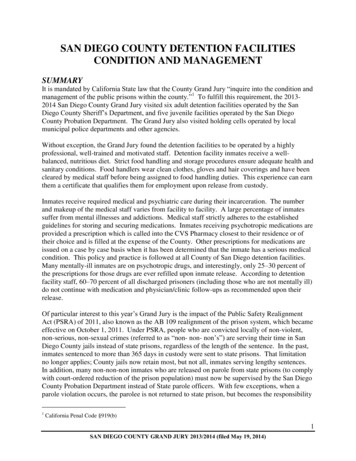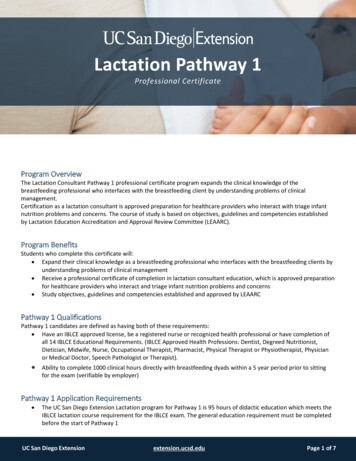
Transcription
SAN DIEGO COUNTY DETENTION FACILITIESCONDITION AND MANAGEMENTSUMMARYIt is mandated by California State law that the County Grand Jury “inquire into the condition andmanagement of the public prisons within the county.”1 To fulfill this requirement, the 20132014 San Diego County Grand Jury visited six adult detention facilities operated by the SanDiego County Sheriff’s Department, and five juvenile facilities operated by the San DiegoCounty Probation Department. The Grand Jury also visited holding cells operated by localmunicipal police departments and other agencies.Without exception, the Grand Jury found the detention facilities to be operated by a highlyprofessional, well-trained and motivated staff. Detention facility inmates receive a wellbalanced, nutritious diet. Strict food handling and storage procedures ensure adequate health andsanitary conditions. Food handlers wear clean clothes, gloves and hair coverings and have beencleared by medical staff before being assigned to food handling duties. This experience can earnthem a certificate that qualifies them for employment upon release from custody.Inmates receive required medical and psychiatric care during their incarceration. The numberand makeup of the medical staff varies from facility to facility. A large percentage of inmatessuffer from mental illnesses and addictions. Medical staff strictly adheres to the establishedguidelines for storing and securing medications. Inmates receiving psychotropic medications areprovided a prescription which is called into the CVS Pharmacy closest to their residence or oftheir choice and is filled at the expense of the County. Other prescriptions for medications areissued on a case by case basis when it has been determined that the inmate has a serious medicalcondition. This policy and practice is followed at all County of San Diego detention facilities.Many mentally-ill inmates are on psychotropic drugs, and interestingly, only 25–30 percent ofthe prescriptions for those drugs are ever refilled upon inmate release. According to detentionfacility staff, 60–70 percent of all discharged prisoners (including those who are not mentally ill)do not continue with medication and physician/clinic follow-ups as recommended upon theirrelease.Of particular interest to this year’s Grand Jury is the impact of the Public Safety RealignmentAct (PSRA) of 2011, also known as the AB 109 realignment of the prison system, which becameeffective on October 1, 2011. Under PSRA, people who are convicted locally of non-violent,non-serious, non-sexual crimes (referred to as “non- non- non’s”) are serving their time in SanDiego County jails instead of state prisons, regardless of the length of the sentence. In the past,inmates sentenced to more than 365 days in custody were sent to state prisons. That limitationno longer applies; County jails now retain most, but not all, inmates serving lengthy sentences.In addition, many non-non-non inmates who are released on parole from state prisons (to complywith court-ordered reduction of the prison population) must now be supervised by the San DiegoCounty Probation Department instead of State parole officers. With few exceptions, when aparole violation occurs, the parolee is not returned to state prison, but becomes the responsibility1California Penal Code §919(b)1SAN DIEGO COUNTY GRAND JURY 2013/2014 (filed May 19, 2014)
of local detention facilities. The impact is clearly being felt by local law enforcement agencies.For instance, the average daily population of the San Diego County adult detention facilities hasincreased from 4,672 in the pre-realignment period to 5,694 on September 30, 2013.2Approximately 31 percent of the total jail population was made up of realigned offenders as ofthat date.Implementation of AB 109 at the County level has been facilitated by the formation of aCommunity Corrections Partnership (CCP) made up principally of the Sheriff's Department, theProbation Department and the District Attorney. The CCP also collaborates with the CountyHealth and Human Services Agency (HHSA) and local law enforcement agencies. One of thebasic foundations of the realignment effort is the utilization of evidence-based practices in theservices to be provided to the inmates or those on probation. Evidence-based practices places anemphasis on achieving measurable outcomes and making sure that the services provided and theresources used are effective. It involves using research and scientific studies to identifyinterventions that reliably produce significant reductions in recidivism. The goals of the CCPare: To efficiently utilize jail capacity To incorporate reentry principles into in-custody programming To incorporate evidence-based practices into supervision, case management andsentencing of offenders.In addition to the active detention facilities operating in the County, the 2013-2014 San DiegoCounty Grand Jury had the opportunity to visually review a closed facility at Descanso. Thisfacility remains an asset, though not currently active as a County detention facility, as the Countycontinues to deal with the space requirements needed as the result of AB 109.The Sheriff’s Department is focusing the bulk of its rehabilitation programs at the longer termdetention facilities (including the East Mesa Reentry Facility and the County Women's Detentionand Reentry Facility) where the inmate’s length of stay is more conducive to longer termrehabilitation efforts.Although the Sheriff’s Department and the Probation Department are doing an excellent jobabsorbing the additional workload, they are fast approaching the maximum available capacitiesof the County’s jails and the sworn personnel available to manage them. On a positive note,construction is currently underway on a new, much needed facility to replace the aging Women’sDetention and Reentry Facility at Las Colinas, which will add a net 400 beds to that facility,giving it a total of 1216 beds for females in County custody.The expansion of the Women's facility, while needed and welcome, poses a significant staffingchallenge for the Sheriff's Department: Approximately 250 additional female deputies must berecruited and trained to serve at the facility in order to comply with existing staffing regulations.With construction completion expected in 2015, this is a high priority task which the Sheriff'sDepartment is addressing.2Source: San Diego Sheriff's Department Detention Facility Fact Sheets prepared for the 2013-2014 San DiegoCounty Grand Jury and Probation Department report to the Board of Supervisors dated 9/30/2013.2SAN DIEGO COUNTY GRAND JURY 2013/2014 (filed May 19, 2014)
Also, a transformation is taking place at the adult male facility at East Mesa. Formerly known asthe East Mesa Detention Facility, the facility has been renamed the East Mesa Reentry Facility toreflect the Sheriff's new strategy of dealing with the inmates. In-custody programming andtreatment now focuses on preparing offenders to return to their communities, ensuring that thereis a smooth transition upon their release. An additional 400 beds are under construction at theEast Mesa Reentry Facility, with completion anticipated in May 2014.Another positive innovation is currently in progress: In cooperation with the VeteransAdministration, the Sheriff's Department is reserving one wing of the Vista Detention Facility tohouse inmates who are military veterans. The wing is being decorated with patriotic themes, andthe Sheriff’s support staff will offer programs and services to meet the special needs of veterans.PROCEDUREThe Grand Jury utilized existing questionnaire review forms to obtain information from facilitydirectors and managers. This included data on staffing and inmate populations before and afterimplementation of AB 109. The Grand Jury collected/reviewed: Questionnaire responses from facility directorsInspection forms completed during site visitsCalifornia Department of Corrections and Rehabilitation's Corrections StandardsAuthority inspection reportsTitle 15 and Title 24 of the California Code of RegulationsFire Safety On-Site Inspection, Environmental Health On-Site Inspection,Medical/Mental Health On-Site Inspection, and Nutritional Health On-Site InspectionPublic Safety Realignment Act (AB 109)County of San Diego Juvenile Justice Commission reportsVarious other documents relating to facilities, operations, staff, and inmates.Members of the Grand Jury reviewed relevant documents and visited the following adultdetention facilities operated by the Sheriff’s Department: San Diego Central JailSouth Bay Detention FacilityWomen’s Detention and Reentry Facility (Las Colinas)George F. Bailey Detention FacilityEast Mesa Reentry FacilityVista Detention FacilityIn addition, the Grand Jury conducted reviews of the following juvenile detention facilitiesoperated by the San Diego County Probation Department: East Mesa Juvenile Detention FacilityRancho del Campo Juvenile Ranch FacilityCamp Barrett Juvenile Ranch FacilityKearny Mesa Juvenile Detention Facility3SAN DIEGO COUNTY GRAND JURY 2013/2014 (filed May 19, 2014)
Kearny Mesa Girls Rehabilitation FacilityThe Grand Jury toured the following holding facilities managed by local cities and otheragencies: San Diego Airport-Harbor Police Carlsbad Police Department Chula Vista Police Department Escondido Police Department La Mesa Police Department Oceanside Police Department San Diego Police DepartmentThe Grand Jury also visited two non-detention facilities operated by the County Health andHuman Services Agency under the Child Welfare Services Division, and one privately-operatedsubstance abuse treatment facility: A.B. and Jesse Polinsky Children’s Center San Pasqual Academy Phoenix House Academy, DescansoThe following operational and support facilities were visited: San Diego County Medical Examiner’s Office San Diego Police Crime Laboratory San Diego County Sheriff’s Crime Laboratory East Mesa Food Processing and Laundry Facility San Diego County Probation Department Work Furlough Program San Diego County Community Transition CenterINMATE DEATHS 2009 – 2013The Grand Jury reviewed specific data on inmate deaths from all causes in San Diego Countydetention facilities for the past five calendar years. The County's detention facilities haveexperienced a steady decline in inmate deaths in custody despite the ever-increasing populationof inmates in custody as a result of AB 109. That trend is reflected in the table at the end of thissection.Among the six adult detention facilities operated by the Sheriff's Department, the San DiegoCentral Jail had the most deaths during this five-year period, 28, followed by the Vista DetentionFacility with 12. George Bailey Detention Facility and the adjacent Facility 8 combined hadeight deaths, the Women's Detention and Reentry Facility had four, and the East Mesa ReentryFacility had one death. No deaths were reported at the South Bay Detention Facility.Total Deaths in San Diego County Sheriff Detention Facilities, Calendar Years 2009-201333San Diego County Sheriff's Fact Sheets prepared for use of the Grand Jury. The figures for 2010 and 2013 havebeen updated since the Interim Detention Facilities Report was released on May 19, 2014.4SAN DIEGO COUNTY GRAND JURY 2013/2014 (filed May 19, 2014)
Totals for all Facilities# of suicides# of Homicides# of Natural CausesOther*Total 04312*Deaths where there was no clear intent to commit suicide (overdose) or deaths that were accidental (during use offorce or medical treatment) where there was no clear intent to kill the person.COMMENDATIONBased on information received during visits to the detention facilities, personal observations, andreview of operational documentation provided by the facilities' staff, the 2013/2014 San DiegoCounty Grand Jury commends the dedicated professional staffs of the San Diego CountySheriff's Department and the San Diego County Probation Department for their efficient serviceto our community. Without exception, the detention facilities reviewed by the Grand Jury aremeeting the requirements of the Board and State of Community Corrections (BSCC), providing aclean and safe environment for the inmates housed there, and adjusting their educational andcounseling programs to meet the reentry success goals under AB 109. We also commend thecommand staffs of the Sheriff’s Department and the Probation Department for proactivelycreating a progressive roadmap for implementing AB 109, utilizing existing limited resources toreduce recidivism and, by extension, the state's prison population.ADULT FACILITIES VISITEDSAN DIEGO CENTRAL JAILThe Grand Jury visited the San Diego Central Jail (SDCJ) on July 31, 2013. The Sheriff’sDepartment provided an extensive briefing that included a PowerPoint presentation and anoverview of all adult detention facilities throughout San Diego County. In addition, facilitycommanders and department heads each provided a summary of their respective facilities andduties.The SDCJ covers 417,000 square feet. It was opened in 1998. The facility houses males only,including inmates of all risk levels. It is supervised by the Facility Commander with a swornstaff of 233. Sworn staff works 12.5-hour shifts and there are 45 deputies on duty at any onetime.SDCJ has a Board and State of Community Corrections (BSCC) rated capacity of 944 inmates.On the day of the Grand Jury's visit, the average daily population was 872. Since the prisonrealignment bill became effective in 2011, the average daily population has increased by 80. Themaximum population has been as high as 941. The facility averages over 56,000 annualbookings. Approximately 43 percent of the inmates have already been sentenced and 57percentare being held pending trial. The average stay of an inmate is 70 days for those sentenced and8.5 days for those being held pretrial. The inmate with the longest sentence as of the date of ourvisit was serving 1,879 days. Prior to AB 109, the longest serving inmate was sentenced to 365days. At the time of the Grand Jury visit, other pertinent facts included:5SAN DIEGO COUNTY GRAND JURY 2013/2014 (filed May 19, 2014)
Number of identified gang members:4168Number of inmates in Immigration & Customs Enforcement (ICE) violations: 45Number of inmates in protective custody:104Inmates are classified on a scale from 1-6 (1 low risk, 6 extreme violence, threat to publicsafety). The process of inmate classification is evidentiary, based on the severity of their pastand current offenses, personal interviews and their behavior in custody. Inmate risk levelclassification begins at initial intake (booking) at SDCJ where extensive medical andpsychological screening is conducted. An inmate’s classification provides a composite profilethat allows appropriate assessment of inmate needs (housing, counseling and training) while atSDCJ and once they are transferred to East Mesa, South Bay or George Bailey detentionfacilities. While in custody, inmates are provided color-coded clothing and wristbands thatidentify their classification and are segregated appropriately. This is done in the interest of bothprotecting low-risk inmates and segregating high-risk inmates to reduce inmate-to-inmate andpotential inmate-to-deputy violence. During an inmate’s incarceration, his classification isevaluated periodically for the purpose of upgrade or downgrade based upon behavior while incustody.The SDCJ central command center uses state-of-the-art touch-screen controls and videosurveillance. From induction to final release, all critical inmate data is maintained in the JailInformation Management System (JIMS). In the event of any emergency or major systemfailure, the command center has the capability of electronically controlling all jail operationswith backup generators. These generators can provide the needed power for this facility for atleast three days.SDCJ has the largest medical/psychiatric care unit of all the detention facilities in the County andthe capacity for a wide range of medical and psychiatric services, including on-site dialysis,infectious disease control, and dental care. SDCJ dedicates one complete floor to inmates whohave medical issues. Services are provided under contract by the University of California SanDiego (UCSD) Medical Center. The facility is staffed with a full-time physician daily, 52Registered Nurses (RNs), and 13 Licensed Vocational Nurses (LVNs). While there is not a fulltime psychiatrist on staff, one is available 24 hours a day. There are two full-time social workerson staff.The licenses of the RNs and LVNs are verified annually. They follow approved standardizednursing procedures. Medical personnel properly inventory and distribute prescribed medicationsaccording to physician’s orders. All medications are stored in a secured location.Documentation of health care for the inmates is handled via electronic medical records.Inmate meals are prepared at the Central Food Kitchen located in the East Mesa CentralProduction Center. They are either served in the inmates’ own dayrooms, or cafeteria style, andinmates are given 30 – 45 minutes for meals.4San Diego County Sheriff's Fact Sheets prepared for use of the Grand Jury.6SAN DIEGO COUNTY GRAND JURY 2013/2014 (filed May 19, 2014)
The Grand Jury found the grievance log up to date. The Penal Code strictly defines and limitsdiscipline options.Despite SDCJ being primarily an in-take facility with the average stay of an inmate spanningonly 70 days, there are limited formal rehabilitation (educational) programs available to inmatesincluding GED readiness, basic computer skills and life skills counseling. Participation in theseprograms is voluntary and qualification is based on both the inmate’s classification (risk level)and behavior while in custody. Involvement in these programs can then be continued uponrelease or upon transfer to a long-term detention facility.SDCJ was last inspected by the Board and State of Community Corrections (BSCC) onJanuary 27, 2012. Findings at that time included non-compliance with the following:Title 24, Section 470A.2.2: Temporary Holding Cells Two of the temporary holding cells exceeded their capacity of 16 inmates at the time ofthe inspection.Title 24, Section 470A.2.8: Dormitories Nine beds were added to each of four dormitories in Level 8 Housing, exceeding the limitof sixty-four inmates.The 2013-2014 Grand Jury revisited the SDCJ on September 19, 2013, to review the status ofcompliance to the above Title 24 requirements. SDCJ staff has made changes in their practicesto accommodate the Title 24 requirements of having no more than 16 inmates in a holding celland sixty-four in a dormitory at any time.During our return visit, we reviewed the process for transfer of inmates to the adjacent courthouse for trial. We learned that there are plans to install state-of-the-art body scanningequipment to be used at intake and in the process of transferring inmates to/from court, to insureall contraband items (drugs and weapons) are discovered.SOUTH BAY DETENTION FACILITYSouth Bay Detention Facility (SBDF) opened in 1982 and is part of the South Bay RegionalJustice Center in Chula Vista. It is a non-booking facility and houses low, medium and highlevel inmate classifications. It has a CSA-rated capacity of 386, and a court-ordered capacity of431. There are four housing modules, theoretically providing beds for 576. However, some ofthe space is currently being used for property storage (typically, the clothing/possessions ofinmates), and SBDF has a “keep separate” list of inmates who must be isolated from others.This includes known gang members and sexual predators. Inmate-on-inmate assaults arerelatively rare. Each housing module has two sections; each section consists of 24 cells withthree beds each. SBDF has 57 sworn staff.SBDF is not a long-term housing facility. Average tim
Carlsbad Police Department Chula Vista Police Department Escondido Police Department La Mesa Police Department . Phoenix House Academy, Descanso The following operational and support facilities











